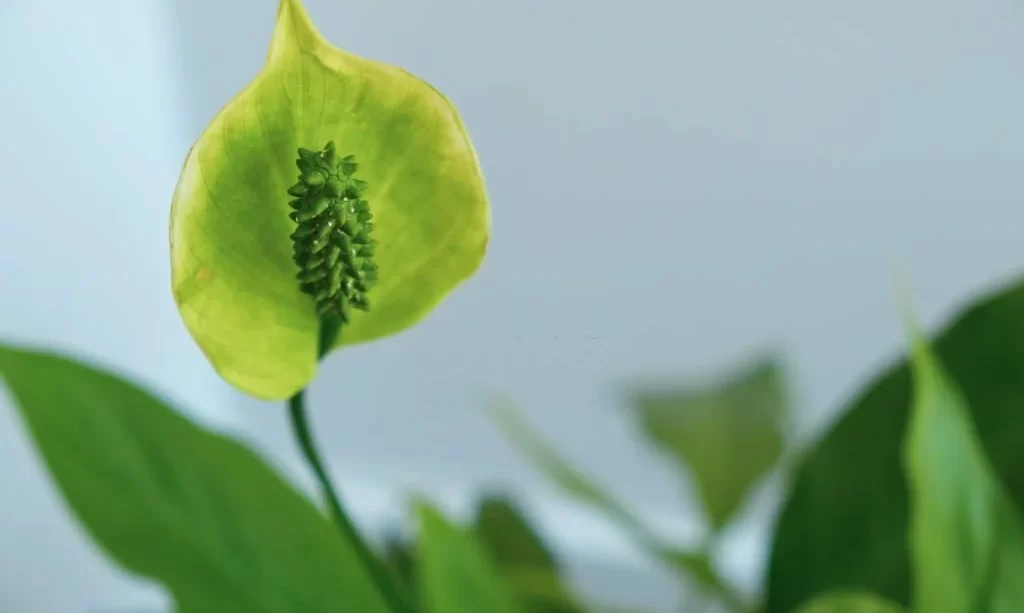Peace lilies, known for their elegant white or creamy flowers, can be a delightful addition to any indoor garden. However, if you’ve noticed that your peace lily’s blooms are appearing green, you might be wondering why. In this article, we will unravel the mystery behind the green color of peace lily flowers. We’ll explore both the natural color variation within the species and the environmental factors that can influence these charming plants. By the end, you’ll have a clear understanding of why your peace lily’s flowers are defying the conventional wisdom of white blooms.
- Tailored Nutrient Blend: Our indoor houseplant fertilizer is formulated with a precisely balanced blend of nutrients, ensuring your plants receive the specific nourishment they need for robust growth and vibrant foliage.
- Optimal Absorption: The unique liquid formulation is designed for efficient nutrient absorption, delivering essential elements directly to the roots and leaves, resulting in quicker and more noticeable plant health improvements.
- Indoor Environment Focus: Developed with indoor plants in mind, our fertilizer takes into account the specific conditions of indoor settings, providing nutrients that cater to the controlled environment of your home.
- Enhanced Growth Patterns: Our fertilizer encourages and supports growth patterns that are well-suited to indoor spaces, helping your plants thrive without excessive stretching or sprawling.
- Mess-Free Application: Applying our specially crafted fertilizer is simple and mess-free, with easy-to-follow instructions. No more worrying about soil spills or residue on your indoor surfaces.
The Natural Color of Peace Lily Flowers
Peace lilies, scientifically known as Spathiphyllum, are renowned for their pristine white blossoms. However, not all peace lilies adhere to this standard. There are exceptional and rare varieties with a natural greenish tint to their flowers. These unique cultivars have leaves and spathes that display varying shades of green, making them a striking choice for those seeking something out of the ordinary in their indoor gardens. So, if your peace lily’s flowers are green, it may simply be due to the specific variety you’ve chosen to cultivate.
Environmental Factors
While peace lilies typically bloom in a soft, creamy white, their flower color can be influenced by environmental conditions. One of the most significant factors is light exposure. The amount of light a peace lily receives directly affects the color of its flowers. Peace lilies in low light conditions may produce greener blooms, while those in bright, indirect sunlight tend to exhibit their classic white hues. So, if your peace lily is placed in a spot with insufficient light, it’s likely the reason behind its green flowers.
Nutrient Imbalance
Maintaining the right balance of nutrients is crucial for the overall health of your peace lily and the color of its flowers. Phosphorus, in particular, plays a significant role in flower color. When a peace lily lacks sufficient phosphorus, its flowers can appear green. To ensure your peace lily’s flowers maintain their desired white or creamy shade, it’s essential to use a balanced fertilizer specifically formulated for flowering plants. Regularly feeding your peace lily with a balanced fertilizer will provide the necessary nutrients for vibrant and correctly colored blooms.
Stress and Overwatering
Peace lilies are sensitive to their growing conditions, and stress factors like overwatering can lead to greenish flowers. Overwatering can result in root rot, which affects the plant’s ability to take up essential nutrients, including those responsible for flower color. To prevent overwatering and the stress it causes, make sure your peace lily is potted in well-draining soil and allow the top inch or two of the soil to dry out between waterings. By maintaining proper watering practices and providing a stress-free environment, you can help your peace lily maintain its natural, beautiful flower color.
Disease or Pest Infestation
Diseases and pests can also contribute to the puzzling green color of peace lily flowers. If your peace lily’s blooms have taken on a greenish hue unexpectedly, it’s essential to inspect the plant for any signs of disease or pest infestation. Common issues to watch out for include fungal diseases, mealybugs, spider mites, or aphids, as these can stress the plant and affect its flower color. Promptly addressing any such problems with appropriate treatments or preventive measures will help your peace lily regain its natural, vibrant flower color.
Rare Green Varieties
Intriguingly, there are certain peace lily varieties that naturally exhibit green flowers, standing out from the conventional white or creamy spathes. These unique cultivars are prized for their distinctive beauty and make for an eye-catching addition to your indoor garden. Varieties such as Spathiphyllum ‘Domino’ and ‘Mojo Lime’ are known for their greenish-hued flowers and can be an intentional choice for those who appreciate a touch of uniqueness in their plant collection. So, if you’ve intentionally selected one of these rare green-flowering peace lily varieties, the green color of the blooms is perfectly normal.
Conclusion
In summary, the green color of your peace lily’s flowers can be influenced by a variety of factors. Understanding the natural variation among peace lily varieties, the impact of environmental conditions like light and water, the importance of nutrient balance, and the potential threats of disease or pests is key to maintaining the desired white or creamy flower color. However, it’s also worth appreciating the charm of rare green-flowering peace lily varieties, which offer a unique twist on the traditional appearance. By following proper care practices and addressing any issues promptly, you can ensure that your peace lily continues to thrive and display its natural, vibrant flower color.




